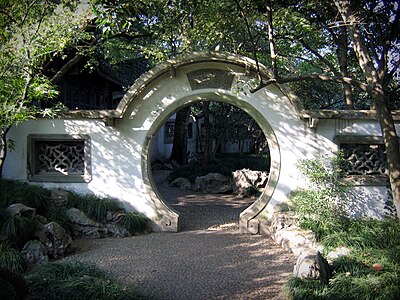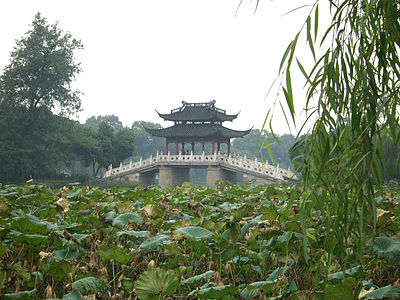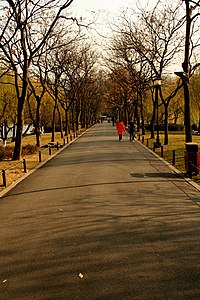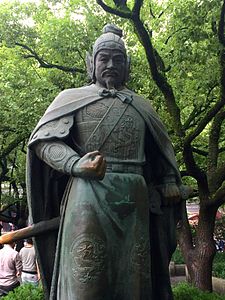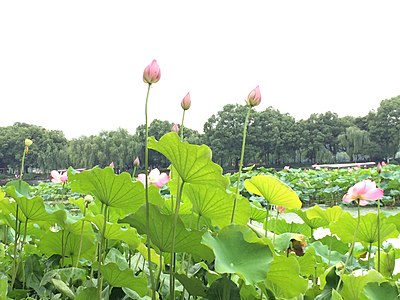West Lake
| West Lake | |||||||||||||||||||||||||
|---|---|---|---|---|---|---|---|---|---|---|---|---|---|---|---|---|---|---|---|---|---|---|---|---|---|
| 西湖 (Chinese) | |||||||||||||||||||||||||
 | |||||||||||||||||||||||||
| Location | Xihu District, Hangzhou, Zhejiang | ||||||||||||||||||||||||
| Coordinates | 30°14′49″N 120°08′39″E / 30.24694°N 120.14417°E | ||||||||||||||||||||||||
| Type | Natural freshwater lake | ||||||||||||||||||||||||
| Primary outflows | The Grand Canal | ||||||||||||||||||||||||
| Catchment area | 21.22 km2 (8.19 sq mi) | ||||||||||||||||||||||||
| Basin countries | China | ||||||||||||||||||||||||
| Managing agency | Management Committee of Hangzhou West Lake Scenic Area | ||||||||||||||||||||||||
| Max. length | 3.2 km (2.0 mi) | ||||||||||||||||||||||||
| Max. width | 2.8 km (1.7 mi) | ||||||||||||||||||||||||
| Surface area | 1,580 acres (6.4 km2) | ||||||||||||||||||||||||
| Average depth | 2.27 m (7.4 ft) | ||||||||||||||||||||||||
| Water volume | 14,290,000 m3 (505,000,000 cu ft) | ||||||||||||||||||||||||
| Residence time | China Standard Time | ||||||||||||||||||||||||
| Shore length1 | 15 km (9.3 mi) | ||||||||||||||||||||||||
| Surface elevation | 10 m (33 ft) | ||||||||||||||||||||||||
| Islands | The Gushan, the Little Yingzhou, the Lake-heart Pavilion, and the Ruan Gong islet | ||||||||||||||||||||||||
| Sections/sub-basins | Outer West Lake, Inner West Lake, West Inner Lake, Small South Lake, Yue Lake | ||||||||||||||||||||||||
| Settlements | Hangzhou | ||||||||||||||||||||||||
| Official name | West Lake Cultural Landscape of Hangzhou | ||||||||||||||||||||||||
| Location | |||||||||||||||||||||||||
| Criteria | (ii)(iii)(vi) | ||||||||||||||||||||||||
| Reference | 1334 | ||||||||||||||||||||||||
| Inscription | 2011 (35th Session) | ||||||||||||||||||||||||
| Area | 3,322.88 ha (8,211.0 acres) | ||||||||||||||||||||||||
| Buffer zone | 7,270.31 ha (17,965.3 acres) | ||||||||||||||||||||||||
| Chinese name | |||||||||||||||||||||||||
| Chinese | 西湖 | ||||||||||||||||||||||||
| Literal meaning | "West Lake" | ||||||||||||||||||||||||
| |||||||||||||||||||||||||
| Location | |||||||||||||||||||||||||
 | |||||||||||||||||||||||||
| 1 Shore length is not a well-defined measure. | |||||||||||||||||||||||||
West Lake (Chinese: 西湖; Wu Chinese pronunciation: [si ɦu]) is a freshwater lake in Hangzhou, China. Situated to the west of Hangzhou's former walled city, the lake has a surface area of 6.39 square kilometres (2.47 sq mi),[1] stretching 3.2 kilometres (2.0 mi) from north to south and 2.8 kilometres (1.7 mi) from east to west.[2] In the lake are four causeways, three artificial islands, and the Gushan, the only natural island.[1] Gentle hills surround the lake on its north, west, and south sides,[1] with the Leifeng and Baochu pagodas standing in pair on the south and north banks. Several famous temples, primarily Buddhist, are nestled in the mountains west of the lake, including the temples of Lingying and Jingci.
A tourist attraction since the Tang dynasty (618-907),[3]: 12 the lake has influenced poets and painters throughout Chinese history for its natural beauty and historic relics.[4] By the Song dynasty (960-1279), during which the dynastic capital moved to Hangzhou, it had became a cultural landmark and one of the most visited tourist destinations of China .[3]: 8 The lake was introduced to Europeans by Marco Polo, making it once a symbol of Chinese urban culture in the West.[3]: 8 The lake is featured on Chinese currency, including the one-yuan note in the 1979 Bank of China Foreign Exchange Certificate and the 2005 Renminbi, as well as in the Chinese passport. A UNESCO World Heritage Site since 2011, the lake is recognised to have influenced garden designs in China, Japan and Korea over the centuries, as "an idealised fusion between humans and nature."[5]
The lake, along with the surrounding hills, is governed by the Management Committee of Hangzhou West Lake Scenic Area, a special administration dedicated to cultural preservation and gardening under the Hangzhou municipal government.[6] The first major Chinese tourist attraction to cancel admission fees,[7] the scenic area is crowded during public holidays.[8] In the 2024 National Day holiday, the area received 4.426 million visitors in seven days, a 30.92% rise from the previous year.[9]
Names
[edit]The first description of the waters near Hangzhou was made in the Book of Han finished in 111, which states,
The Western Commandery Captain of Qiantang was stationed at the Wulin Hills, where the Wulin River originates. The river flows eastward into the sea, covering a distance of 830 li [350 km; 220 mi].
This statement is widely interpreted as the first mention of the West Lake, while the Wulin Hills were believed to be the hills near the Lingyin Temple.[10]
Historically, the lake has been referred to by various names, but only two have gained widespread acceptance: Qiantang Lake, named after Hangzhou's ancient name; the West Lake, due to its location to the west of the city.
Bai Juyi was among the first to refer to the lake as "West Lake," mentioning it in two of his poems.[note 1] During the Song Dynasty, the name "Qiantang Lake" gradually fell out of favour, as most poems and writings preferred to use "West Lake." Su Shi was the first to use the name in official documents, in his request to the Imperial Court for the dredging of the lake in 1090.
History
[edit]Formation
[edit]About 4,400 to 2,500 years ago, as sea levels fell, the Hangzhou-Jiaxing-Huzhou plain began to emerge, while the West Lake was merely a shallow bay. Over time, the Qiantang River gradually deposited sand and rocks outside this bay. About 2,000 years ago, a lagoon was formed. Streams from the surrounding mountains transformed the water into freshwater, but ongoing silt deposits gradually reduced the lake to a swamp.[11]
In local folklore, when Qin Shi Huang (259–210 BC) visited Hangzhou, the West Lake was still part of the Qiantang River. The giant rock on the north bank of West Lake was said to be where the emperor anchored his fleet. According to the Records of the Grand Historian, during his visit in 210 BC, the emperor was halted in Hangzhou by the strong tide of the Qiantang River and had to take a detour westward to reach Shaoxing.[12]
As the earliest historical record to mention the lake, the Treatise on Geography in the Book of Han, completed in 111, describes the water body as originating in the Wulin Hills[note 2] and flowing eastward into the sea for 350 km (220 mi). During the Eastern Han era (25–220), a seawall was constructed to protect the emerging land east to the lake from the strong tide of the Qiantang River.[13] In 591, the government seat of Hangzhou, originally on the west shore, was relocated to the newly built walled city east to the lake. With the completion of the Grand Canal, Hangzhou as its destination, became a transport hub of China.[14]
Early development
[edit]
Before the Tang dynasty (618-907), the West Lake was a small and shallow body of water, but continuous hydraulic engineering efforts gradually transformed it.[15] In 781, Li Mi, then mayor of Hangzhou, ordered the construction of six wells in densely populated areas, connecting them with underground pipes made of bamboo and clay. This system allowed water from the lake to be supplied to the city. The only remaining well from this project is the Xiangguo Well, located west of Jinting Bridge on Jiefang Road.Later, during his tenure as mayor from 822 to 824, Bai Juyi ordered the restoration and reinforcement of the lake's deteriorating old dykes, adding a dam and dredging the lake, to control water flow and support irrigation. This project led to the construction of the Baisha Causeway, later known as the Bai Causeway in his honour.

With the collapse of the Tang dynasty, Hangzhou became the capital of the Wuyue Kingdom (907–978). During this period, sediment accumulated rapidly in West Lake, making dredging a routine maintenance task. In 927, Qian Liu, the king of Wuyue, organised an army of 1,000 men to clear grasses and deepen the lake, thereby preserving the lake’s water body. As part of their devotion to Buddhism, the Wuyue rulers built numerous temples, pagodas, shrines, and grottoes around the lake. They expanded Lingyin Temple and built Zhaoqing, Jingci, Li’an, Liutong, and Taoguang temples, as well as the Baochu, Liuhe, Leifeng, and White pagodas. This extensive religious development earned Wuyue the title of the "Buddhist Kingdom."

The Song dynasty (960 to 1279) continued the dredging work. Su Shi, a famous writer who served as mayor of Hangzhou from 1071 to 1073, ordered the lake to be dredged and used the dredged mud to create a wide, extended causeway, on noticing the drought caused by weed-clogged irrigation channels. The Su causeway, named after the mayor building it, was lined with willow trees and spanning 2.6 km (1.6 mi), which includes six bridges, each named for its distinct features.
Emergence of tourism
[edit]
Su Xiaoxiao, a renowned courtesan and poet of Southern Qi (479-502), was buried at the Xilin Bridge near the West Lake. Her life and poetry have inspired later poets, including Li He and Wen Tingyun. Over time, local history and culture became intertwined with the natural beauty of Hangzhou. One such example is the poem by Bai Juyi, which celebrates Su Xiaoxiao’s beauty and her connection to the enchanting scenery of the region,
涛声夜入伍员庙, |
The tides at night resound near Wu Zixu’s shrine, |
Literary works by renowned literati contributed to the fame of West Lake among Chinese intellectuals. Later in the Song dynasty, when Su Shi (1037–1101) famously compared West Lake to Xizi, one of the renowned Four Beauties of ancient China, the lake became known as the Xizi Lake.[3]: 12 In his poem, he writes,
水光瀲灧睛方好, |
The shimmering water shines in clear light, |
While these literary works left the West Lake with rich cultural relics, wars and conflicts in northern China—including invasions by the Khitan, Jurchen, and Mongols—triggered significant migration southward to Hangzhou, leading to urbanisation and economic prosperity. With city walls blocking much of the natural scenery, West Lake became a favoured destination for urban residents seeking respite from the demands of city life and political turmoil.[3]: 10-11
In the Song dynasty, aesthetic appreciation of landscapes was made a popular business.[3]: 10 Diverse entertainment options, with standardised routes and viewing orders, became available to cater to various preferences and budgets.[3]: 12 Tour guides, seasonal markets and specialty shops emerged.[3]: 12 The Ten Scenic Spots of the West Lake was named.[16] Boating on the lake was a popular pastime, with records noting hundreds of intricately carved, elegantly decorated boats gliding gracefully over the water. For visitors, touring West Lake combined material enjoyment and sensory experience of the landscape.[3]: 12

The growing number of visitors contributed to a rich literary legacy of poems, miscellanies, and gazetteers. These visitors included migrants from the north, examination candidates, and local officials reporting to the central government. The imperial examinations held every three years filled Hangzhou with educated individuals, who often enjoyed the lake's beauty and consulted fortune-tellers at lakeside temples. Those who passed the exams either served in the central government or were appointed to other provinces. For many, visiting West Lake remained a cherished activity, inspiring poems that reflected on their experiences and memories of the scenery.[3]: 66
The booming tourism led to different interpretations. The lake was regarded as a literary tradition, a symbol of the state and a part of local history and knowledge, but for some, a symbol of extravagance and luxury that led to anxiety.[3]: 67-84 [17] One of the most famous portrayal comes from Lin Sheng, who penned a poem as a satirical commentary on how people were engrossed in their indulgence in Hangzhou's pleasures, rather than making efforts to reclaim the lost northern capital:
山外青山樓外樓, |
Beyond the hills, more hills rise, beyond the pavilions, more pavilions stand. |

In 1142, General Yue Fei, eagerly engaged in the northern expedition to reclaim northern China, was executed by the dovish emperor and premier and later buried by the lake.[16] In 1162, a nearby temple was repurposed to commemorate Yue Fei. The Wind and Waves Pavilion, where Yue was executed, has been preserved near the West Lake. In 1215, the painter Muqi Fachang renovated the abandoned Liutong Temple.
Shortly after the Mongol conquest of China, the West Lake remained socially vibrant. The official records show that in 1309, the city received more than 1,200 foreign visitors within half a year, many from Turkestan and Europe. Among the visitors was Marco Polo, who praised it as “the most splendid heavenly city in the world.” Under Kublai Khan, the lake was dredged and renamed the “Pond of Freeing Captive Animals”, while parts of the lake area were gradually cultivated into farmland.
Later, tourism at the West Lake gradually declined as wealthy families and nobility enclosed portions of the lake for private use. Much of the lake silted up, turning into swampland. Local residents blamed the fall of the Song dynasty on the lake, believing that the upper class’s indulgent lifestyles and focus on the lake’s entertainments contributed to the dynasty’s decline. This association with luxury and excess made local authorities and residents reluctant to invest in the lake's restoration.
Restoration and revitalisation
[edit]
With the Ming dynasty overthrowing Mongol rule and restoring stability across China, Hangzhou regained its prosperity by the mid-15th century, yet in 1442 and 1456, the lake dried out due to droughts.[16]
In the 1500s, Hangzhou governor Yang Mengying, supported by imperial envoy Ju Liang, secured approval and funding from the imperial government to dredge West Lake, despite significant resistance from local elites. The dredging extended the water surface from west of Su Causeway to Hongchun Bridge and Mao Jia Bu, restoring the lake's appearance to that of the Tang and Song dynasties. The excavated silt was used to widen Su Causeway and to construct a new causeway in western Inside Lake, named Yanggong Causeway, named after the governor.

During the Ming dynasty, West Lake was dredged multiple times, with the excavated silt used to create two artificial islands: Huxin Island and Xiao Ying Zhou. In 1607, Qiantang County governor Nie Xintang constructed a circular causeway from the south to the west of Fangsheng Pond on Xiao Ying Zhou, creating the distinctive view known as "Island in Lake, Lake in Island." In 1611, Yang Wanli expanded the outer bank, completing the project by 1620. Adjacent to the pond, three small stone pagodas were erected, collectively known as "Three Ponds Mirroring the Moon".

The Manchu took Hangzhou in 1645, which led to a new walled city within Hangzhou's walled city, alongside the West Lake.[16] During the Manchu-led Qing dynasty, West Lake’s scenic beauty was highly valued by Manchu rulers, spurring restoration and enhancement efforts. In the Yongzheng period, West Lake spanned 7.54 square kilometres, though over 20 acres were shoals. Governor Li Wei initiated a dredging project funded with 42,742 silver taels, constructing stone weirs in key locations to manage silt accumulation and maintain water levels. Later, in 1800, Governor Yan Jian proposed further dredging, and under Governor Ruan Yuan’s supervision, excavated silt was piled to form “Ruan Gong Dun” (Lord Ruan’s Pier), shaping the modern lake. In 1864, the West Lake Dredging Bureau was established, led by local official Ding Bin, to manage ongoing lake maintenance.
In the High Qing era (1683–1799), emperors frequented the lake, leaving significant relics. The Kangxi Emperor inscribed titles for the Ten Scenic Spots of West Lake, which were later carved into stelae beneath pavilions. The Yongzheng Emperor expanded these scenic spots to eighteen, further promoting the lake’s appeal. The Qianlong Emperor continued this legacy by composing poems and erecting stelae for the Ten Scenic Spots and naming the "Eight Scenic Spots of Dragon Well." In Beijing, royal gardens, including the Garden of Delighted Spring and the Old Summer Palace, were built in resemblance to the landscape of the West Lake.[16] This era also saw the publication of A Glance at Lakes and Hills by local scholars Qu Hao and Qu Han, which covers over 1,000 scenic sites around West Lake, making it the earliest known guide to the area.
Republican era
[edit]
Following the 1911 revolution that ended the Qing dynasty, the Manchu Banner Garrison was demolished, and the imperial properties upon the lake were nationalised.[16] The imperial garden was converted to Zhongshan Park, named after Sun Yat-sen. Zhejiang Martyrs' Memorial and tombs for Xu Xilin and Qiu Jin were built, in memory of those who died for the revolution. From 1923 to 1924, the deserted Qian Liu Temple was renovated and converted to a garden. In 1933, the leaning Baochu Pagoda was revamped. 1933, Zhejiang's provincial government erected "Chen Yingshi Statue", "North Expedition Martyr Memorial Tower" and "Martyrs of 88 Division in Songhu Campaign Memorial Stela" at the piers of Third Park, Second Park and Fifth Park, respectively. However, due to continuous digging by stealth on its base, Leifeng Pagoda, after lasting nearly a thousand years, collapsed on September 25, 1924.
During the Republican era, the lake became open to the public, with the opening of several public parks. The completion of the Shanghai-Hangzhou railway in 1916 has made commercial tourism to the lake became one of the pillar industries of Hangzhou.[18]: 4 According to the Hangzhou municipal government, from 1930 to 1936, the recorded tourists to Hangzhou were counted to 32,845. In 1929, the provincial government of Zhejiang held Westlake exposition, attracting over 20 million visitors.

A number of historical events took place on the lake. In 1922, the Community Party of China held the Hangzhou Plenum on the lake, which initiated the first collaboration between the Communists and Nationalists. In 1924, Rabindranath Tagore visited the lake and made a public speed. In 1927, Chiang Kai-shek and Soong Mei-ling spent thier honeymoon on West Lake at Cheng Villa. In 1928, the National Art School was founded on the Gushan Island on the lake. In 1937, Zhou Enlai secretly met with Chiang Kai-shek at Chiang's West Lake villa, to negotiate a united front against Japanese invasion. After the war with Japan, tourism at the West Lake became flourishing, yet the city itself suffered from hyperinflation. [16]
People's Republic
[edit]With the city seized by the Communists in 1949, major hydrological works, along with other construction projects, took place, to exemplify socialist achievements.[18]: 141 During the era of Mao Zedong, Mao frequently lived at villas upon the lake, especially Liu Villa.[16] A new botanical garden and flower garden was opened on the lake's west shore. The parks of Fish Viewing at the Flower Pond and Orioles Singing in the Willows were constructed. Lingyin Temple, Jingci Temple, Yue-Wang Temple, Three Ponds Mirroring the Moon, Lake-heart Pavilion and other spots were renovated. In 1959, West Lake received over 1,400 foreign tourists, over 2,300 tourists from Hong Kong and Macao and over five million domestic visitors.

During the Cultural Revolution, Liutong Temple and another temple were destroyed.[19] Zhou Enlai ordered the closure of the Lingyin Temple to prevent it from being destroyed.[16] But repairs were later made to many scenic sites, due to the visits by Cambodian prince Norodom Sihanouk and President United States Richard Nixon.
With the end of the Cultural Revolution, tourism to the lake revitalised. In 1983, the Hangzhou government refurbished temples and pavilions upon the lake. They also expanded Galloping Tiger Spring and established Curved Yard and Lotus Pool in Summer Park. The new site Exploring Plum Blossoms at Ling Peak was introduced, complemented by cultural events at Huanglong Cave and Ruangong Island.
In 1984, local media and societies held public vote to rate the new "Ten Scenic Spots" of the lake. Cloud-Sustained Path in a Bamboo Grove and Misty Trees by Nine Streams were thus selected. In 1985, a pump at Zhakou to draw 300,000 cubic meters of water daily, were built to refresh the water in the lake. a sewage interception project, completed in 1981, installed over 17 kilometers of buried tunnels and 10 pumping stations.

In 2000, the West Lake exposition was relaunched, drawing 1.4 million visitors. The "West Lake Southern Side Renovation Project" began in 2002, granting public access to four newly incorporated parks. On October 25, 2002, a new 71.7-meter pagoda was built at the site of the original Leifeng Pagoda, which had collapsed 78 years earlier.[20]
Notable attractions
[edit]Ten Scenic Spots of the West Lake
[edit]Traditionally, there are ten best-known scenic spots on the West Lake, each remembered by a four-character epithet. Collectively, they are known as the "Ten Scenic Spots of the West Lake" (西湖十景), of which the rating dates back to the Song dynasty. Each is marked by a stele with an epithet written in the calligraphy of the Qianlong Emperor.[21]
| Name | Explanation | Image |
|---|---|---|
| 曲院風荷
Lotus in the Breeze at Crooked Courtyard[22] |
Zigzag bridges spanning across the pool filled with lotus leaves and blossoms, located on the northwest part of the lake. Historically, | 
|
| 平湖秋月 | Historically referred to any place to watch the moon from the lake. A sightseeing platform with the name was built at the west end of the Bai Causeway | 
|
| 斷橋殘雪
Lingering Snow on Broken Bridge[24] |
The snow on the bridge creates an illusion of a break when viewed from afar, giving rise to the name "Broken Bridge." | 
|
| 雷峰夕照
Leifeng Pagoda in the Sunset |
Leifeng Pagoda in the Sunset | 
|
| 雙峰插雲
Two Peaks Piercing the Clouds |
On rainy or misty days, parts of the South and North Peaks seem to emerge and disappear within the clouds, with their tops still visible above the mist | 
|
| 柳浪聞鶯 | Originally a royal garden of the Song dynasty, a park filled with willows swaying in the wind and bird songs | 
|
| 花港觀魚 | Floral garden with ponds filled with numerous red fishes, located at the southwest of the lake | 
|
| 三潭印月 | Three stone pagodas near the artificial island of Little Yingzhou, with lanterns that reflect on the lake's surface alongside the moonlight | 
|
| 南屏晚鐘
Evening Bell Ringing at the Nanping Hill |
The sound of bells at the Jingci Temple at the Nanping Hill | 
|
| 苏堤春晓
Spring Dawn at Su Causeway |
The Su Causeway in early spring | 
|
Other attractions
[edit]- Yue Fei Temple, the tomb and memorial hall to Yue Fei.
- Lingyin Temple, a Buddhist monastery and surrounding hills.
- Long Jing tea farms (龙井茶园), an area renowned for the quality of Tea.
- Jingci Temple
- Galloping Tiger Spring (虎跑梦泉), a spring famous for its mineral water
- Tomb of Su Xiao Xiao (苏小小墓)
- The West Lake Museum (located on the lake shore) is dedicated to the cultural heritage of the West Lake.
- Former Residence of Chiang Ching-kuo
Geography
[edit]The outline of the lake body of the West Lake is nearly oval, and the bottom of the lake is relatively flat. The natural surface water source of the lake is four streams: Jinsha River, Longhong River, Chishangrun (Huiyingrun) and Changqiao River. West Lake is located in the southeastern edge of China's hills and the northern edge of the subtropical zone. The annual total solar radiation is between 100 and 110 kcal/cm2, and the sunshine hours are between 1800 and 2100 hours.[25]
The outline of the lake body of the West Lake is almost oval, the bottom of the lake is relatively flat. The catchment area of the west lake is 21.22 square kilometers, with annual runoff of 14 million cubic meters and storage of nearly 14 million cubic meters. The west lake draws water from the Qiantang River, about 120 million cubic meters per year. The natural surface water sources of the lake are Jinsha stream (金沙涧), long hong stream (龙泓涧), Qishan stream (huiyin stream)(赤山涧(慧因涧)) and changqiao stream (长桥溪).
The storage capacity is about 14.294 million cubic meters. The average depth of the lake is 2.27 meters, with the deepest being about 5 meters and the shallowest being less than 1 meter. The average annual precipitation on the lake is 5.629 million cubic meters. The scour coefficient of the water system is 1.49. When the gate of the reservoir is closed in a dry season, the flow rate is equal to 0. Even in the flood period, the general flow rate is only below 0.05 m/s.
The water level of the lake is maintained at the yellow sea level of 7.15 meters, ±0.05 meters. The highest water level of 7.70 meters and the lowest water level of 6.92 meters, with a difference of 50 centimeters.[26]
Ecology
[edit]Flora
[edit]

Around the west lake, there are 184 families 739 genera 1369 species of seed plants, including 28 species of gymnosperms in 19 genera and 7 families, 1273 species of angiosperms in 675 genera and 150 families, 68 species of ferns in 45 genera and 27 families. Currently, there are 21 species of rare plants are listed in the first-grade state protection, including Zhejiang nan, wild soybean and short spike bamboo, and 63 species are listed the second-grade state protection.[27]
Peach Blossom: On the lake banks and Su and Bai Causeways a large number of willows and peach trees are planted. It is said one willow is accompanied by one peach tree. Other horticultural plants include magnolia, cherry, Confederate rose, etc. The blooming season of peach tree in Hangzhou usually ranges from end of February to middle of April.
Lotus: Some sites in Hangzhou were named after lotus, such as lotus pond (荷花池頭) and lotus lane (荷花塘弄). There is traditional food called "lotus cake". The fossil of lotus seeds was unearthed at Kuahuqiao site in Xiaoshan, which indicates at least before the Tang dynasty there was cultivated lotus. Yang Wanli of the Song dynasty wrote poem, "Lotus leaves grow to the sky with endless green, lotus blossoms bathed in the sunlight appear especially red. (接天蓮葉無窮碧,映日荷花别样紅), which brought high reputation to the lotus in West Lake. Nowadays, there are 14 lotus cultivation areas in the lake, totally 130 Chinese acres. Most are in "North Inside Lake" and "Yue Lake". According to statistics, West Lake lotus starts to bloom in early June, and reaches peak blossom time in late June. It can last till late August or early September.
Osmanthus: As the city flower, osmanthus is one of representative plants of Hangzhou. Poet Bai Juyi wrote "search osmanthus around the temple on hill in the middle of Autumn", indicating osmanthus had been cultivated as early as in the Tang dynasty. Osmanthus trees have been massively planted in parks around the lake, and the best-known locations to appreciate are "Sweet Osmanthus Rain at Manjuelong Village", one of "New Ten Scenes of West Lake", and Hangzhou Botanical Garden. Osmanthus can be divided into four major species,[citation needed] Thunbergii group (金桂), Latifolius Group (銀桂), Aurantiacus Group (丹桂) and Fragrans Division (四季桂). Among them, the Thunbergii and Latifolius are the best. Every year around mid-autumn, the sweet-scented osmanthus blossoming is a highlight of tourism in Hangzhou. In addition to its elegant looks, osmanthus is also edible. Thunbergii and Latifolius boast intensive sweet scent, and are natural ingredients for seasoning. Pickled osmanthus blossoms mixed with white sugar became a traditional food of Hangzhou, "Sweet Osmanthus" (糖桂花). West Lake Osmanthus blooming period commences from early September, lasting till early November.
Plum blossom: Lin Bu (林逋), a famous recluse in the Song dynasty, lived on Solitary Hill. His poem Little Plum Blossom of Hill Garden (山園小梅) became the best known poem praising the flower and enriched the cultural contributions of the plum blossoms of West Lake. The opening line of the poem says, "When everything has faded they alone shine forth, encroaching on the charms of smaller gardens" (眾芳搖落獨暄妍,占斷風情向小園).[28] Ling Peak, Solitary Hill and West Creek have long been the three finest spots of plum blossom cherishing in Hangzhou. The flowering season is typically around the Spring Festival, from late January to middle February.
Tulip: The "Prince Bay Park" (太子湾公园) of Hangzhou imported almost all species of tulips from Netherlands in 1992, and held annual tulips exhibition ever since. It has become a new scenic spot on the lake bank. The normal tulips blossom season spans from middle of March to end of April.
Fauna
[edit]Mallards, halcyons and koi carp are among the most frequently spotted animals in the lake. Squirrels loiter among the trees on the bank.
Literary works
[edit]
Over the centuries, the beauty and culture of West Lake has attracted numerous literati, who left behind works of literature and poetry to describe the lake. For example, Dream in West Lake and The Enchiridion of Lake and Mountain recorded a lot about West Lake and ancient Hangzhou historic anecdotes. Poets such as Bai Juyi, Su Shi, Xu Zhimo and Hu Shih also wrote countless poems about West Lake. The Chinese legend Legend of the White Snake is also set in West Lake in Hangzhou and has been adapted into films and television series over the years.
Influences
[edit]| "I've never traveled to Hangzhou's West Lake But seem to have met it in my dreams someplace: A vague and indistinct expanse of water and clouds Where lotus leaves merge with weeping-willow branches." |
| —Huang Zunxian (1848–1905), excerpts from A Trip to Lake Abundant (translation by Jerry Dean Schmidt)[29] |
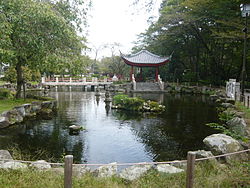
West Lake is said to be the incarnation of Xi Shi, one of the Four Beauties of ancient China. Since ancient times, West Lake was associated with a large number of romantic poets, profound philosophers, national heroes and heroines. West Lake was also the retreat for many Chinese writers of the past. The Northern Song Dynasty poet Lin Bu, shunning the life of being an official, lived in seclusion by West Lake for twenty years, and dedicated himself to the cultivation of peach and plum blossoms.[30] The great Ming dynasty essayist Zhang Dai, wrote a number of essays about West Lake in Reminiscence and Dream of Tao'an (陶庵夢憶), and a whole book: Search for West Lake in Dreams (西湖夢尋). West Lake has had a profound impact on Far Eastern landscape designs,[5] and its features have often been imitated by other palaces and gardens, such as Kunming Lake at the Summer Palace in Beijing, the central ponds of the Kyu Shiba Rikyu Garden and Koishikawa Kōrakuen Garden in Tokyo, Japan, among others.
Due to its prominent historical and cultural status, West Lake was selected as a National Key Scenic Resort in 1982, one of Ten Scenic Resorts in 1985 and a national 5A tourist resort in 2006.
Along with its cultural importance, West Lake historically was also of value for local commercial fishermen. According to statistics from 1977, the lake had an annual fish yield of 1300 kg/hectare, quite a bit more than for some larger lakes (that is, East Lake of Wuhan had a yield of only 450 kg/ha).[31]
Gallery
[edit]-
Galloping Tiger Spring
-
A traditional Xī Hú entrance
-
The Guozhuang Garden, one of many historic gardens in the West Lake
-
Lotus in the Breeze at the Winding Courtyard
-
View of the Su Causeway
-
Statue of Yue Fei, a patriotic military general from the Southern Song dynasty, near the West Lake
-
Lotus at the West Lake during summer
References
[edit]Notes
[edit]Citations
[edit]- ^ a b c "浙江省测绘与地理信息局关于启用浙江省主要河流长度、流域面积、主要湖泊面积数据的公告". 浙江省测绘与地理信息局. 2010-09-30. Archived from the original on 2013-12-02. Retrieved 2011-09-05.
- ^ 《杭州市志》. 中华书局. pp. 第二卷风景名胜篇第一章. ISBN 7101017193. Archived from the original on 2013-03-19.
- ^ a b c d e f g h i j k Duan, Xiaolin (2020). The rise of West Lake: a cultural landmark in the Song Dynasty. Seattle: University of Washington Press. ISBN 978-0-295-74711-8.
- ^ Yang, Hongxun and Huimin Wang (1982). The classical gardens of China: history and design techniques. Van Nostrand Reinhold Co. p. 111. ISBN 0-442-23209-8.
- ^ a b "Ancient Chinese cultural landscape, the West Lake of Hangzhou, inscribed on UNESCO's World Heritage List". UNESCO. Retrieved 2011-06-24.
- ^ "Hangzhou West Lake Scenic Area Administration Commission". Hangzhou Municipal Committee and Hangzhou Municipal People's Government. 2015-08-27.
- ^ You, Xudong (2022-11-03). "How Hangzhou Freed West Lake and Upended Chinese Tourism". SixthTone. Retrieved 2024-11-01.
- ^ "West Lake | Hangzhou, China | Attractions". Lonely Planet. Retrieved 2024-11-01.
- ^ "442.6万人次 同比增长30.92% 国庆假期西湖景区又一次成为"顶流"". 中共杭州市委、杭州市人民政府. 2024-10-08.
- ^ "史话杭州·追寻历史:武林水". 杭州党史方志微信公众号. 2024-06-26.
- ^ "Introduction". West Lake Museum. Retrieved 2024-11-01.
- ^ "(古迹拾遗) 你知道杭州有大佛寺吗?". 中国民主促进会浙江省委员会. Retrieved 2024-11-01.
- ^ 陈志坚 (2018-11-15). "华信海塘与杭州城发展关系再探". 《杭州文史》第九辑.
- ^ "隋唐时代的杭州,如何崛起为"东南第一州"?".
- ^ 林华东、林盈盈. "大自然的赐予一一西湖的形成". 《秦汉以前古杭州》.
- ^ a b c d e f g h i Barmé, Geremie R. (2011). "A Chronology of West Lake and Hangzhou". China Heritage Quarterly (28). ISSN 1833-8461.
- ^ Jacques Gernet (1962). Daily life in China, on the eve of the Mongol invasion, 1250–1276. Stanford University Press. p. 23. ISBN 0-8047-0720-0.
- ^ a b He, Qiliang (2023). The people's West Lake: propaganda, nature, and agency in Mao's China, 1949-1976. Honolulu: University of Hawaiʻi Press. ISBN 978-0-8248-9559-4.
- ^ "Japan Spirit and Form #4: Ink Painting". Archived from the original on 2021-12-21 – via www.youtube.com.
- ^ Dai Xiaoxiao and Pan Jiankai (2002-10-26). "The Building of New Leifeng Pagoda Completed". Guangming Daily (in Chinese). Retrieved 2008-06-01.
- ^ "West Lake Official".
- ^ ""Lotus in the breeze at crooked courtyard" inkstick, Qing dynasty, Qianlong reign (1736-1795)". The National Palace Museum Open Data Platform. Retrieved 2024-11-02.
- ^ ""Autumn moon over calm lake" inkstick, Qing dynasty, Qianlong reign (1736-1795) < Images < The National Palace Museum Open Data Platform". theme.npm.edu.tw. Retrieved 2024-11-02.
- ^ "Lingering Snow on Broken Bridge < Images < The National Palace Museum Open Data Platform". theme.npm.edu.tw. Retrieved 2024-11-02.
- ^ "杭州西湖 - 生态中国网". www.eco.gov.cn. Retrieved 2023-10-30.
- ^ "Welcome to westlakemusem!". www.westlakemuseum.com. Retrieved 2019-03-30.
- ^ "Welcome to west lake museum!". www.westlakemuseum.com. Retrieved 2019-03-30.
- ^ Red Pine. Poems of the Masters. Port Townsend, Copper Canyon Press, 2003, p.453.
- ^ Jerry Dean Schmidt (1994). Within the human realm: the poetry of Huang Zunxian, 1848–1905. Cambridge University Press. p. 81. ISBN 0-521-46271-1.
- ^ "Hangzhou's West Lake, the most beautiful in China". Imperial Tours.
- ^ American Oceanography Delegation, Committee on Scholarly Communication with the People's Republic of China (1980), Oceanography in China: a trip report of the American Oceanography Delegation submitted to the Committee on Scholarly Communication with the People's Republic of China, Issue 9 of CSCPRC report, Committee on Scholarly Communication with the People's Republic of China (U.S.)., National Academies, p. 13, ISBN 9780309030465



